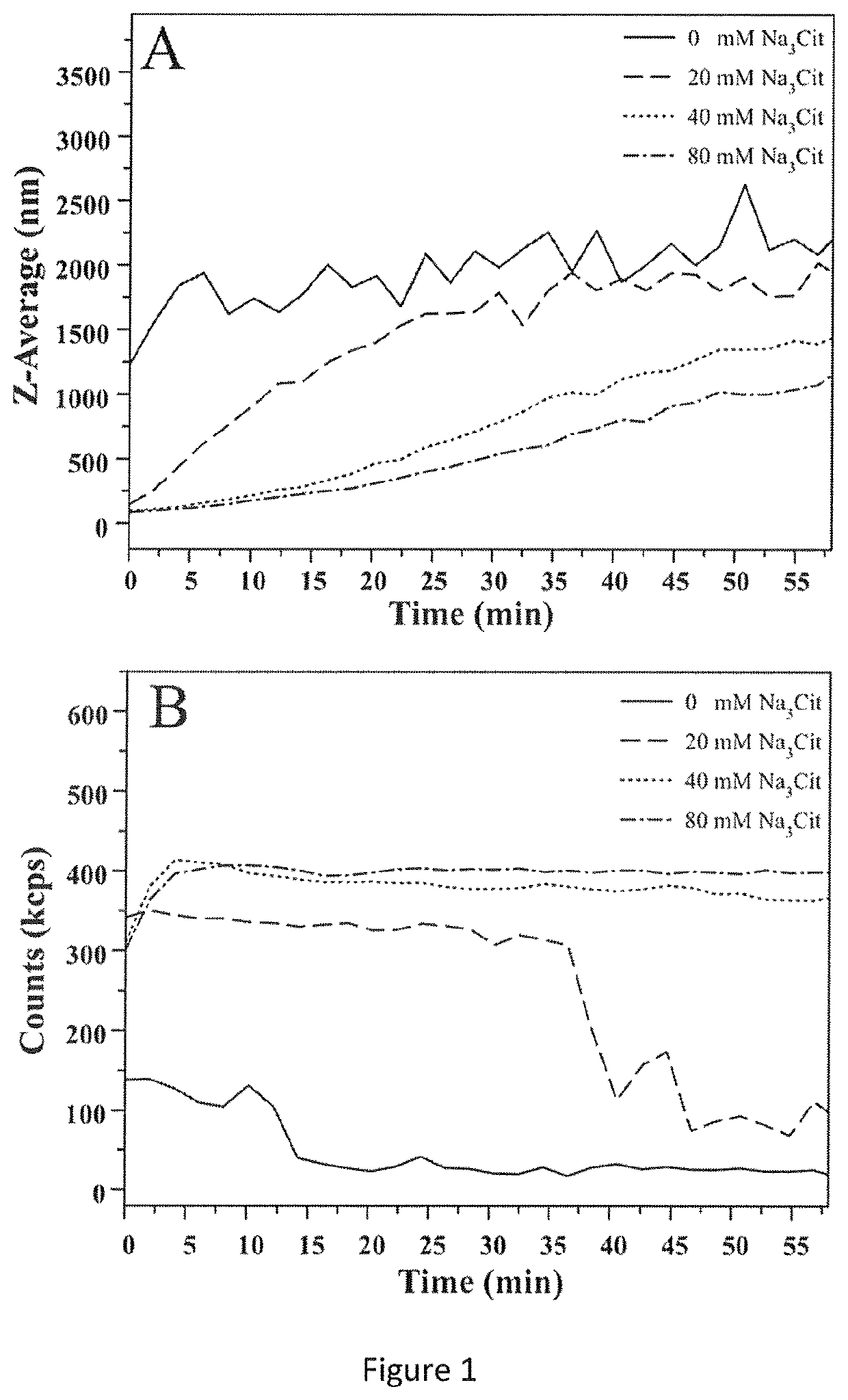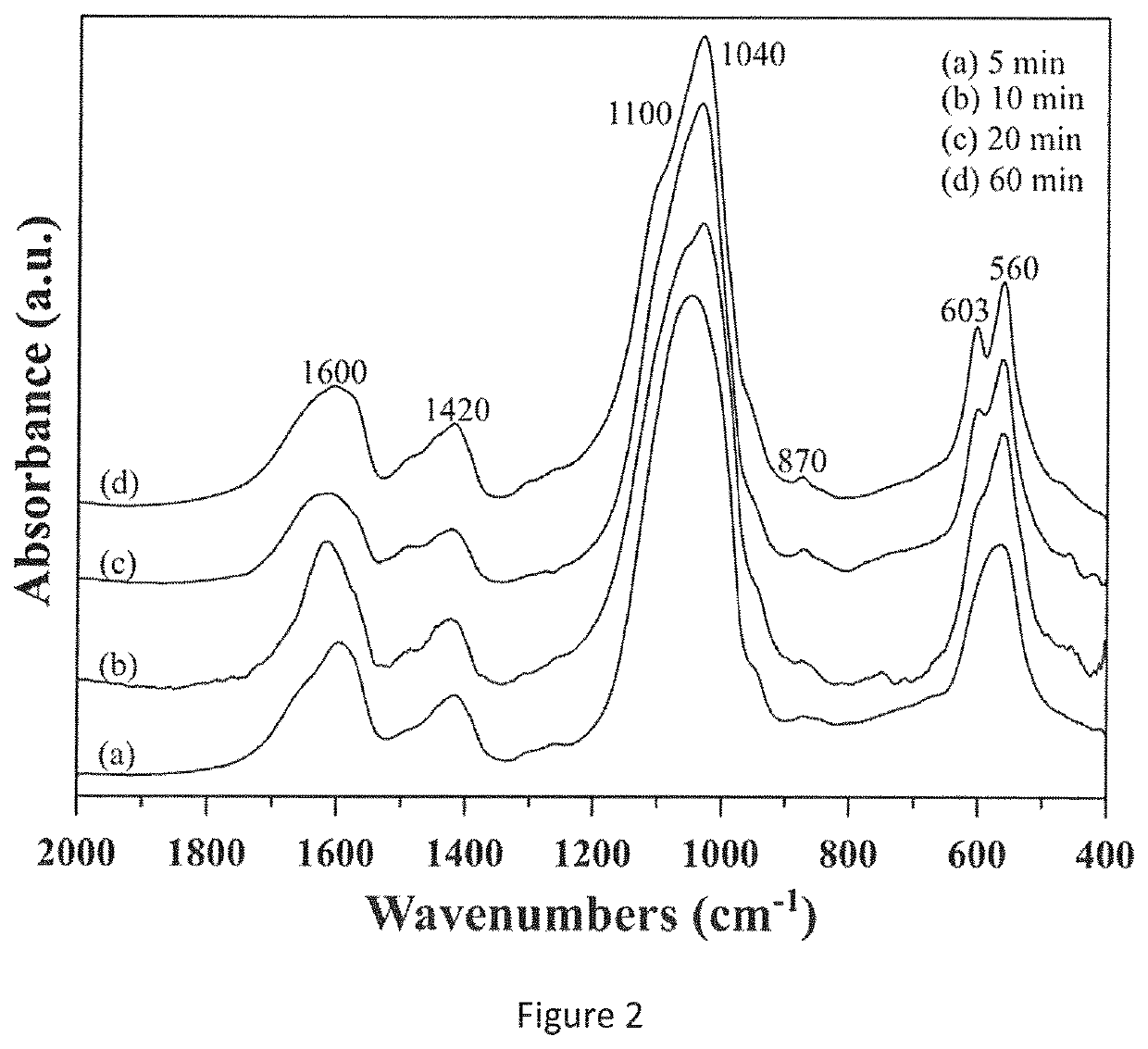Products for the delivery of therapeutic/diagnostic compounds to the heart
a technology for diagnosing and therapeutic compounds, applied in the direction of cardiovascular disorders, drug compositions, peptide/protein ingredients, etc., can solve the problems of slow cell dissolution/accumulation, drug application, and non-selectivity of tissue-specific delivery
- Summary
- Abstract
- Description
- Claims
- Application Information
AI Technical Summary
Benefits of technology
Problems solved by technology
Method used
Image
Examples
example 1a
n of the Calcium Phosphate Nanoparticles (CaP-NP) of the Invention
[0064]A solution containing: 12.5 volumes of a solution of CaCl2 (10-50 mM) and Na3 (C6H5O7) (40-200 mM), 1 volume of a solution of NaOH (0.1-0.5 M) and 12.5 volumes of a solution of Na2HPO4 (12-60 mM) was prepared and then placed in a water bath at 37° C. for 5 min.
[0065]To remove non-reacted reagents, the solution of CaP-NP was subjected to dialysis for 6 hours in a cellulose dialysis membrane having a cutoff of 3500 Dalton and immersed in 400 ml of bidistilled water. The solution was then recovered and stored in a refrigerator at 4° C. The amount of CaP was assessed by freeze-drying of the sample and subsequent weighing of the inorganic residue. The final concentration of the aqueous suspension of CaP was in the range from 60 to 300 μg / ml, as a function of the concentration of reagents.
[0066]To prepare the nanoparticles, the synthesis reaction between Ca2+ and PO43− was carried out at pH 10 adjusting the pH by addi...
example 1b
Citrate Ion and of the Temperature and Time Conditions on the CaP-NP of the Invention
[0069]In order to assess the essentiality of the presence of citrate ions in step a), the effect of citrate on the dimensions and on the colloidal stability of CaP-NP was assessed in advance by DLS.
[0070]Equal volumes of solutions of Na2HPO4 (24 mM) and CaCl2 (20 mM)+Na3Cit (20, 40, 80 mM) were mixed directly in the disposable cuvette, kept at 37° C. for 5 minutes and subjected to DLS measurements to assess the size and stability of the CaP-NP precipitate in the absence or in the presence of citrate. Different concentrations of sodium citrate (20, 40, 80 mM) were used.
[0071]The hydrodynamic diameter and the number of photons per second were measured for a continuous period of 60 minutes by DLS (FIG. 1A, B).
[0072]The data shown in FIG. 1A, where the Z-average of the CaP-NP synthesized in the presence and absence of citrate was measured as a function of the crystallization time, clearly show that the ...
example 1c
Step b) of the Invention
[0080]In order to remove non-reacted ions during crystallization, dialysis was used as indicated in example 1A.
[0081]In order to test the optimal time so that all the excess ions in the reaction environment are removed by dialysis, the conductivity of the dialysis medium over time was assessed and a plateau was observed after 6 hours (FIG. 3A). The conductivity plateau reached indicated that the ion exchange from the reaction medium to the dialysis medium had ended and that most non-reacted ions had been transferred in the wash water. The ζ-potential of CaP-NP after the dialysis time was measured as shown in Table 2 below.
[0082]
TABLE 2Dialysis time (hours)ζ-potential (mV)2+37.0 ± 0.74−35.6 ± 0.66−39.5 ± 1.5
[0083]The results indicated that increasing the dialysis time decreased the average mean hydrodynamic diameter of CaP-NP, while ζ-potential remained constant. The stability of CaP-NP after 6 hours of dialysis had been confirmed by DLS (FIG. 3B). FIG. 3B sho...
PUM
| Property | Measurement | Unit |
|---|---|---|
| temperature | aaaaa | aaaaa |
| temperature | aaaaa | aaaaa |
| temperature | aaaaa | aaaaa |
Abstract
Description
Claims
Application Information
 Login to View More
Login to View More - R&D
- Intellectual Property
- Life Sciences
- Materials
- Tech Scout
- Unparalleled Data Quality
- Higher Quality Content
- 60% Fewer Hallucinations
Browse by: Latest US Patents, China's latest patents, Technical Efficacy Thesaurus, Application Domain, Technology Topic, Popular Technical Reports.
© 2025 PatSnap. All rights reserved.Legal|Privacy policy|Modern Slavery Act Transparency Statement|Sitemap|About US| Contact US: help@patsnap.com



